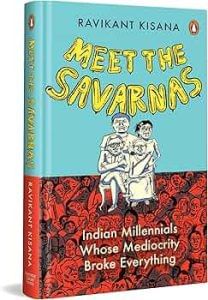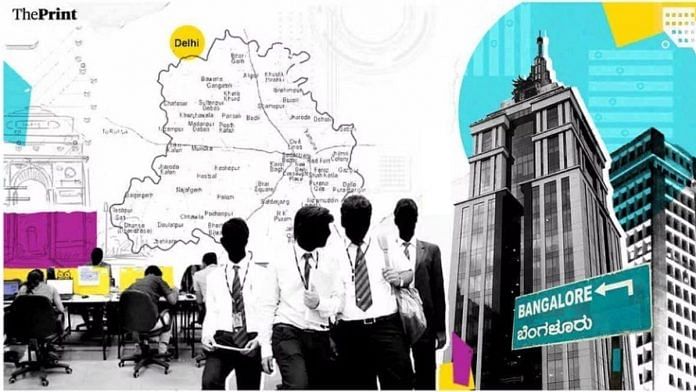Corporate India, in its contemporary form—with its dense network of business schools, locally situated MNCs, state-sponsored IT parks and start-up hubs, an aggressively pro-market media, premium real estate boom and malls full of glamour brands—is a recent outgrowth of this new Brahman–Bania alignment.
This savarna reconfiguration is both a product of neoliberal market reforms and a backlash against the social justice clamour of ‘Mandal politics’. It is a new vision of independent India, constructed because the older paternalistic ‘mai-baap’ state, which ruled through an overgrown Brahman–Kayastha bureaucracy and rural feudal power, was beginning to crack under the pressure of electoral mobilizations from below the glass floor.
By shifting the locus of power to the corporate sector and bestowing upon it the sheen of cultural aspiration and validation, the savarnas bought themselves more time. They paved the way for almost twenty years of a strong savarna–corporate state under the ruling government—a set-up that is now facing a strong backlash from the marginalized groups demanding the return of ‘big welfare’ from the state as evidenced by election results in the general elections of 2024 and subsequent state elections of Haryana, Maharashtra and Delhi.
It is not possible to understand Modi’s unexpected and unprecedented struggle in (and since) the 2024 Lok Sabha elections without examining the factors that led to the creation of his savarna–corporate state, its broad features and the one-dimensional world view of the millennial savarnas who led the charge.
Also read: Guru Nanak was a critic of caste, Timurid rule. Yet Khatris in service of Mughals followed him
The late 1990s onwards—the small blip of the 2008 recession notwithstanding—was an era of (compared to today) cheap business school fees, small batch sizes and rising placement packages (sometimes increasing by 20 to 30 per cent year-on-year). The MBA was suddenly the new dream degree. For a generation of young students, the Common Admission Test (CAT) was all that stood between them and earning lakhs of rupees—amounts of money that, in the preceding age of scarcity, even urban savarnas above the glass floor had toiled their whole lives to secure.
As business schools expanded their batch sizes and new ones popped up, the conversation on reservation and diversity in admissions and hiring was silenced. In fact, many savarna ‘intellectuals’ gleefully claimed that India’s ‘MBA revolution’ was possible only because it was merit-based and free of reservation.
How far that is true remains open to question, as this ‘revolution’ seems to have been driven more by global capital shifts and neoliberal state policy than by any unique pedagogical innovation in these MBA programmes—and certainly not by the diktats of a caste-exclusionary admission policy. The MBA entrance exam typifies this.
The CAT as an exam has always had a relatively simple syllabus, relying more on the time crunch for competitive selection. Aspirants don’t just have to find the correct answers, they have to do it in the shortest possible time to do well in the exam. This has led to the rise of a parallel industry of coaching centres, where students are taught ‘shortcuts’, tips and tricks to cut down their response time. Ultimately, doing well in the exam is not just a matter of knowledge or skill, but rather boils down to the practice of time management tips taught at these centres.
Access to these coaching centres has always been prohibitively expensive. When I wrote the CAT in 2005, these centres were already charging Rs 20,000 and upwards for preparation ‘packages’ ranging from three months to a year. These prices have only increased since then. In a country where a vast majority of families have an average monthly income of less than Rs 10,000, this essentially prices out everyone below the ‘glass floor’ from a shot at an MBA and upward mobility.
Additionally, as mentioned in Chapter 2, poverty has multiple dimensions in a caste-segregated society like India. Accessing the money to train for the competitive exam is just one piece of the puzzle. A vast majority of people below the glass floor did not even know or understand what an MBA was and the possibilities it offered. It was very public yet very gatekept knowledge.
When I was preparing for the CAT, my father initially refused to support the coaching fees. In his world view, the only ‘safe jobs’ were in engineering or medicine. Even law was considered unstable or irrelevant. Like many in my milieu, I too had only ever seen lawyers either in Bollywood films or sitting on the pavement with typewriters under an umbrella, typing out legal documents.
Neither archetype seemed particularly rich or influential. Only much later in life did I learn how powerful and elite a career in law could be. By comparison, an MBA was even ‘newer’ in the public imagination and hyped in the contemporary discourse of the time.
Elite savarnas, with their intergenerational literacy and connections within academic and industry circles, quickly understood the value of an MBA. Meanwhile, a vast majority of talented marginalized individuals continued to toil to crack entrance examinations for public sector jobs in banking, railways or the civil services. The aggregated costs of socially stratifying knowledge and education were borne by tens of thousands of families who could have lifted themselves out of poverty. This was made worse by exclusionary admission policies in B-schools and a larger discourse that framed management as a ‘merit-based’ domain, free from interference and the encumbrances of caste and social justice policies.
This knowledge gap was further compounded by the fact that, at the time, only the top metropolitan cities had elite-tier teachers and coaching infrastructure, leading to a very heavy urban savarna bias in the MBA batches from the first decade of 2000s. This was further reinforced by the admission process itself.
The CAT was just the first step of the selection process; admission was contingent on a good performance in the ‘Group Discussion and Personal Interview’ (GD/PI) round. This was where rich savarnas who had studied in top-tier English-medium schools had a distinct advantage. Admission committees would routinely look for intangible, unverifiable criteria such as the
‘X-factor’, confidence and charisma—which essentially boiled down to fluent English-speaking, fashion sense and personal grooming. Often, the interview round would degenerate into outright intimidation, justified as preparing candidates for the ‘stress’ of the job.
For first-generation learners—those who had attended schools where spoken English was not the norm, and who lacked the money or cultural awareness to groom themselves in sync with formal fashion trends—this aggressive environment put them at a distinct disadvantage, as they were already operating from a place of very low confidence. To compensate, they would have to enrol for yet another coaching package—the ‘GD/PI preparation package’—where they were taught body posture, hand gestures and other such inane criteria, none of which had anything to do with the academic or professional ability of the student.
In fact, so deeply is this belief internalized within the Indian corporate set-up that even today, mandatory formal dress codes remain commonplace in MBA programmes, where students are expected to constantly ‘perform’ confidence via power poses and direct rhetorical speech (usually while delivering a fancy PowerPoint spectacle).
At a time when tech billionaires such as Zuckerberg, Musk and Bezos—whom management types idolize—are often seen in smart casuals, and when corporate culture itself has leaned towards flexibility, informality and breaking down hierarchical barriers, many Indian business schools still penalize students for not wearing formal clothes, ties or crisp suits to daily classes or invited talks featuring some industry figurehead.
Huddled together in stiff formal wear, unsuited for the local weather, sweating and suffocating, these young students resemble feckless, timid conformists rather than the bold, inspiring leaders of tomorrow that these institutions claim to be building. The overworking of students is mistaken for rigour, unquestioning absorption of outdated maxims and boring industry anecdotes is accepted as insight, and any deviation or critical interrogation of this is seen as a lack of seriousness or talent. Any talk of social justice and inclusion, especially based on caste, is considered political or worse, ‘anti-business’.
Despite this hostility in the pedagogical culture of management programmes and the lack of reservations in private management colleges, several SC/ST/OBC students did get into MBA programmes. However, in the absence of any critical, introspective pedagogy as part of their management training, many ended up epistemically internalizing the savarna worldview.
 This excerpt from Ravikant Kisana’s ‘Meet the Savarnas: Indian Millennials Whose Mediocrity Broke Everything’ has been published with permission from Penguin Random House.
This excerpt from Ravikant Kisana’s ‘Meet the Savarnas: Indian Millennials Whose Mediocrity Broke Everything’ has been published with permission from Penguin Random House.






